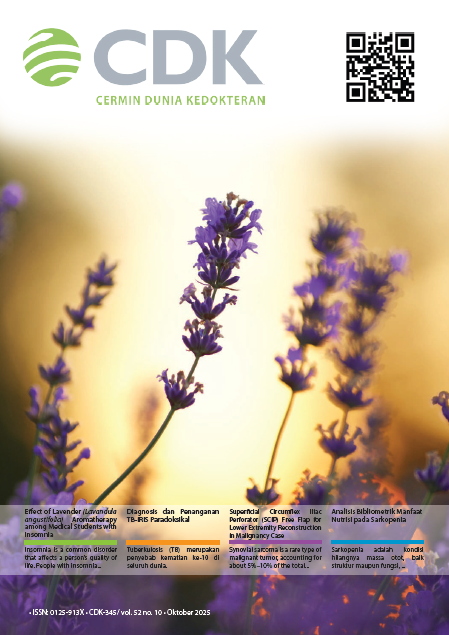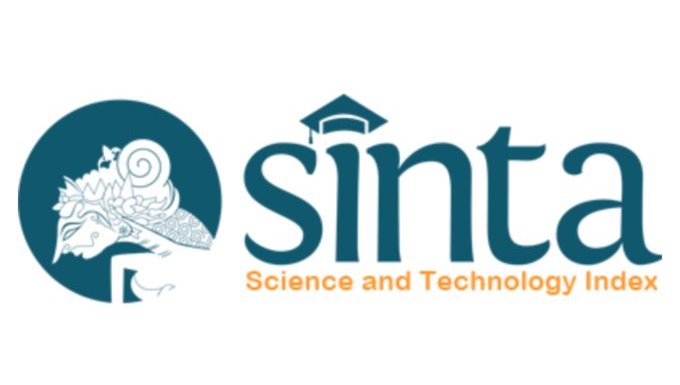The Effect of Vitamin D on the Immune System of Leprosy Patients
DOI:
https://doi.org/10.55175/cdk.v52i10.1673Keywords:
Immune, leprosy, vitamin DAbstract
Leprosy is a chronic infectious disease caused by Mycobacterium leprae. Vitamin D is a fat-soluble vitamin that plays an important role in bone metabolism with an anti-inflammatory and immune-modulating properties. Recent studies show a role of vitamin D on the immune system of leprosy patients. Vitamin D in its active form (1,25 (OH)2 D binds to the vitamin D receptor on macrophages. Vitamin D stimulates the production of cathelicidin and defesin, antimicrobial peptides that can kill Mycobacterium leprae. Vitamin D enhances the Th1 immune response by producing IL12, which is important against intracellular bacteria. Vitamin D suppresses excessive TH2 immune response to prevent disease progression. Vitamin D deficiency has a strong negative correlation with increased levels of pro inflammatory cytokines such as TNF -α. TNF-α, an inflammatory modulator, has been found to be significantly elevated in skin lesions of leprosy patients experiencing type 2 leprosy reactions. High levels of TNF-α play a direct role in myelin sheath damage, bone resorption stimulation, and inhibition of bone collagen synthesis. These factors likely explain clinical symptoms such as neurological disorders and disability in leprosy patients. Based on the above findings, vitamin D has effects on the immune system of leprosy patients.
Downloads
References
World Health Organization. Fact sheets of leprosy [Internet]. 2023 [cited 2024 Nov 15]. Available from: https://www.who.int/news-room/factsheets/detail/leprosy.
Kementerian Kesehatan RI. Laporan kinerja direktorat P2PM. Bidang Pencegahan dan Pengendalian Kementrian Kesehatan RI [Internet]. 2023. Available from: https://ppid.kemkes.go.id/wp-content/uploads/2024/10/FINAL_LAKIP-KEMENKES-2023_compressed.pdf.
Bhandari J, Awais M, Robbins BA, Gupta V. Leprosy [Internet]. 2023 [cited 2024 Nov 18]. Available from: https://www.ncbi.nlm.nih.gov/books/NBK559307/.
Kementerian Kesehatan Republik Indonesia. Pedoman nasional pelayanan kedokteran tata laksana kusta. Kementrian Kesehatan RI [Internet]. 2020. Available from: https://repository.kemkes.go.id/book/130.
Mungroo MR, Khan NA, Siddiqui R. Mycobacterium leprae: pathogenesis, diagnosis, and treatment options. Microb Pathog. 2020;149:104475. doi: 10.1016/j.micpath.2020.104475.
World Health Organization. Frequently asked questions on leprosy [Internet]. 2013 [cited 2024 Nov 17]. Available from: https://iris.who.int/bitstream/handle/10665/205085/B5044.pdf?sequence=1.
Hoseinzadeh E, Taha P, Wei C, Godini H, Ashraf GM, Taghavi M, et al. The impact of air pollutants, UV exposure and geographic location on vitamin D deficiency. Food Chem Toxicol. 2018;113:241–54. doi: 10.1016/j.fct.2018.01.052.
Rebelos E, Tentolouris N, Jude E. The role of vitamin D in health and disease: a narrative review on the mechanisms linking vitamin D with disease and the effects of supplementation. Drugs. 2023;83(8):665-85. doi: 10.1007/s40265-023-01875-8.
Institute of Medicine (US) Committee to Review Dietary Reference Intakes for Vitamin D and Calcium. Dietary reference intakes for calcium and vitamin D. Ross AC, Taylor CL, Yaktine AL, Del Valle HB, editors. Washington (DC): National Academies Press (US); 2011. PMID: 21796828.
Li NS, Nanji K. A review on the role of vitamin D in asthma. Cureus. 2017;9(5):e1288. doi: 10.7759/cureus.1288.
Wacker M, Holick MF. Vitamin D - effects on skeletal and extraskeletal health and the need for supplementation. Nutrients. 2013;5(1):111-48. doi: 10.3390/nu5010111.
Landry SC, Ruppe DM, Grubbs EG. Vitamin D receptors and parathyroid glands. Endocr Pract. 2011; 17(Suppl 1):63-8. doi: 10.4158/EP10325.RA.
Hilma RF, Widaty S, Marissa M, Ilyas M. Association between serum level of vitamin D (25-hydroxyvitamin D) and plasma level of vitamin D receptor with bacteriological index in leprosy patients. Dermatol Reports. 2023;15(4):9705. doi: 10.4081/dr.2023.9705.
Singh I, Lavania M, Pathak VK, Ahuja M, Turankar RP, Singh V, et al. VDR polymorphism, gene expression and vitamin D levels in leprosy patients from North Indian population. PLoS Negl Trop Dis. 2018;12(11):e0006823. doi: 10.1371/journal.pntd.0006823.
Lu'o'ng Kv, Nguyen LT. Role of the vitamin D in leprosy. Am J Med Sci. 2012;343(6):471-82. doi: 10.1097/MAJ.0b013e318232a6cf.
Grossi de Oliveira AL, Chaves AT, Santos Cardoso M, Gomide Pinheiro GR, Parreiras de Jesus AC, de Faria Grossi MA, et al. Hypovitaminosis D and reduced cathelicidin are strongly correlated during the multidrug therapy against leprosy. Microb Pathog. 2020;147:104373. doi: 10.1016/j.micpath.2020.104373.
Matzner M, Al Samie AR, Winkler HM, Nemeth J, Grasnek A, Indra A, et al. Low serum levels of cathelicidin LL-37 in leprosy. Acta Trop. 2011;117(1):56-9. doi: 10.1016/j.actatropica.2010.09.007.
Lyrio EC, Campos-Souza IC, Correa LC, Lechuga GC, Vericimo M, Castro HC, et al. Interaction of Mycobacterium leprae with the HaCaT human keratinocyte cell line: new frontiers in the cellular immunology of leprosy. Exp Dermatol. 2015;24(7):536-42. doi: 10.1111/exd.12714.
Facchini L, Venturini E, Galli L, de Martino M, Chiappini E. Vitamin D and tuberculosis: a review on a hot topic. J Chemother. 2015;27(3):128-38. doi: 10.1179/1973947815Y.0000000043.
Toruan TL, Devi M, Theodorus, Rivai AM. Relationship between 25-hydroxy vitamin D levels and type of Morbus Hansen. Bioscientia Medicina: J Biomed Translat Res. 2021;5(9):883-9. https://doi.org/10.32539/bsm.v5i9.407.
Rusyati LM, Adiguna MS, Wiraguna AAGP, Puspawati NMD, Sudarsa P. Correlation of serum vitamin D receptor level with bacteria index in multibacillary leprosy patients at Sanglah General Hospital, Bali-Indonesia. Biomed Pharmacol J. 2019;12(1). https://dx.doi.org/10.13005/bpj/1662.
Mandal D, Reja AH, Biswas N, Bhattacharyya P, Patra PK, Bhattacharya B. Vitamin D receptor expression levels determine the severity and complexity of disease progression among leprosy reaction patients. New Microbes New Infect. 2015;6:35-9. doi: 10.1016/j.nmni.2015.04.001.
Vazquez CMP, Netto RSM, Barbosa KBF, Rodrigues de Moura T, de Almeida RP, Duthie MS, et al. Micronutrients influencing the immune response in leprosy. Nutr Hosp. 2014;29(1):26-36. doi: 10.3305/nh.2014.29.1.6988.
Wang G, Narayana JL, Mishra B, Zhang Y, Wang F, Wang C, et al. Design of antimicrobial peptides: progress made with human cathelicidin LL-37. Adv Exp Med Biol. 2019;1117:215-40. doi: 10.1007/978-981-13-3588-4_12.
Dennison CL, de Oliveira LB, Fraga LAO, E Lima RS, Ferreira JA, Clennon JA, et al. Mycobacterium leprae-helminth co-infections and vitamin D deficiency as potential risk factors for leprosy: a case-control study in South-Eastern Brazil. Int J Infect Dis. 2021;105:261-6. doi: 10.1016/j.ijid.2021.02.048.
Downloads
Published
How to Cite
Issue
Section
License
Copyright (c) 2025 Florentina Ranni Eka Rovanza

This work is licensed under a Creative Commons Attribution-NonCommercial 4.0 International License.





















